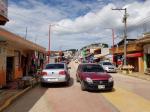July 3rd, 2018
Today I headed out to some cenotes, pronounced sen-ar-tas. These are basically underground caves with water in them. We stopped at a market first, in a small town called Acanceh. The market was a small country one that had fruit, meat and other fresh produce – all good to see where the locals shop and what is available, sometimes a little frustrating when you can’t buy the stuff because you have nowhere to keep or cook it! There are also some Mayan ruins here, we saw a pyramid from the carpark, but didn’t have time to look around them.
From there we got to the Santa Barbara Cenotes fairly quickly, which are in the Homun area. This is a fairly commercial setup, and with that you get some nice change rooms, reception area and a restaurant. But we got there fairly early, so there were very few people there. Getting there early lets you beat the crowds and the heat!
A horse drawn cart took us to the cenotes area – you could also walk or ride. The trails are quite good, but it is fairly hot so the horse drawn cart was our choice! We were the first ones there, so we had the place to ourselves – even better!
The first cenote, Cascabel was lit up with blue lights and had steps leading to the water. Having never been to a cenote before, I was a little unsure of what to actually expect – would these ones be like the Instagram photos that take your breath away or would it be a little more like the caves we have in Australia (which can still take your breath away, but are something we’re a little more used to)? The steps down were damp, but well constructed, leading to a deck area which was built above the water. Inside the walls were fairly bare – some roots traversed the cave walls, but there were no plants and very little life inside this cenote. But, it was so quiet in this one and only one or two fish swimming in the clear blue water. If the lights weren’t on, it would have been quite dark as there was only a small opening at the top. The water was not cold and was good to swim in. We spent about 25 mins there, until some people arrived and we moved to the next one.
The second, cenote Chaksikin, was a lot bigger – deeper and more open, with more light coming in, meaning there was more wildlife around, such as fish and birds. There were a few native tohs hanging around, a blue bird with a long tail and then blue feathers at the end. This one also had some staligtites and long tree roots on the side of the cave, heading toward the water. Small fish and some catfish were in the water.
This was probably the best of the three we saw. We spent quite a bit of time here, until the people came, and then we moved to the third.
The third, Xoch’, was the most open and because there were more birds, the water was not clear, but more dirty – and was not inviting to swim in at all, although it was much warmer due to the sun shining on it. There were fish here as well and iguanas hanging around the top on the surface. The entrance to this one had been excavated, but i wouldn’t have liked to have found it accidentally by walking through the bush as you would fall straight in.
After we finished here we had some lunch at the restaurant then headed back to Merida. We took a ride on a tour bus, which was all in Spanish, but at least we got to see more of the town. There’s some really nice old buildings around the town of Merida, all worthwhile visiting if you have time.
While in Merida, I’d also had a look on the map for some La Parisina stores after deciding to get that soft comfy object that had been gnawing at me, as this would be the last opportunity I’d have to buy that . Now it was about the hunt. I was on a mission! There were about 5 of these stores, all within a block or two of the town square. I couldn’t understand why you would have 5 of the same chain of shops within about 100m of each other, but as I went from shop to shop, looking for what I wanted, they all seemed to vary every so slightly in the stock they sold. So I got to the first one and looked around – nothing here. With my limited Spanish (aka nil) it was entirely pointless asking the shopkeeper for help, so when I saw none at the first one, I headed to the next shop. I saw some more Mexican flags, which if I didn’t already have would be a cause for celebration, but they were not what I was looking for in this case. The shops surrounding the area were all of a similar vein – fabric or craft shops. It was almost a surprise that there were so many of these type of shops in the city. If you were a person who sews, you would absolutely love this area! So onto the next La Parisina – to be fair, after the second I’m not sure how many of the stores I visited – at least 3, quite possibly 4. As I walked into yet another, I was beginning to think that maybe I’d missed my chance and I was running out of shops – the fact that the world cup was still on and Mexico was still alive gave me some hope, but it was fading with each shop. I headed to the back of this shop though, doing a sweep along the aisles looking for the cherished item. Then I saw something looking a little promising! A basket tucked away up the back, half empty, but with a world cup looking sign above it. I walked quickly over and there they were! A depleted pile, but I only needed one. Or did I? After the effort I took to find this cherished item, was one enough? Quickly calculating the space required to transport this, not wanting to damage it by over squashing anything and bring home pancakes instead of something plump and cushy, I settled on one. So what was this item? It was a Mexico soccer shirt, but made into a shirt shaped cushion – perfect for somebody who loved the soccer and loved watching it while sitting on the couch with piles of cushions! It would go very well with a blanket purchased earlier in the trip! But there was still another decision to make – what shirt number and player to get? In the end I settled on Chucky – to be honest I had no idea whether chucky was even a player or a nickname, but it sounded cool.
Having decided, actually trying to pay for it was another problem. In this place you had to hand over the item – I must admit I was a bit apprehensive at letting chucky out of my sight so soon – and then go to a separate counter and pay for the item. It took 3 staff members to facilitate this process. Completely inefficient but I guess at least it keeps people in a job. So now I had Chucky! The perfect souvenir for a friend back in Aus.
On the way back to the hotel, we ran into some others from our tour group heading out to a restaurant for tea. We decided to join them, so headed off with them. I carefully placed chucky at my feet and set about ordering something to eat.
After eating, we all paid and left, intending to head out to another free cultural show in the opposite direction. A couple of minutes from the restaurant I stopped in horror, turning and bolting back to the restaurant. After the search for chucky, I had left him back at the restaurant! I dashed back to the restaurant and there was a staff member who handed him over to me! Boy was I glad to have that back! I hurried back to the others who were still trying to figure out where I’d gone in such a hurry!
The free cultural show that night was open air dancing, a band played and anyone was free to get up and join in. Not quite as entertaining as the previous night, but still better than sitting in the hotel.
Our room in Merida at the colonial hotel had one of the smallest bathrooms I’ve seen in a long time, perhaps ever. You couldn’t pick up the cat, so don’t worry about trying to swing it!
- Ruins at Acanceh in the town centre, Mexico
- The market area at Acanceh, Mexico
- Acanceh market, Mexico
- The horse and cart at Santa Barbara Cenotes
- Our little railway cart at Santa Barbara Cenotes
- Inside the Cascabel cenote, Santa Barbara Cenotes
- The stair well into the Cascabel cenote
- Roots enjoying the moisture in the Cascabel cenote
- Small stalactites, Cascabel cenote
- The massive entrance to the Chaksikin Cenote at the Santa Barbara Cenotes
- The native toh flits between the cool of the cenote and the warmth above ground
- The open cenote Xoch’
- Xoch’ cenote, the third and most open at Santa Barbara Cenotes
- The roots of the tree stretch a long way down searching for the water, Xoch’ cenote
- Peering through the top of the Xoch’ cenote
- Lunch at the Santa Barbara Cenotes
- The streets outside the Colonial Hotel, Merida
- Searching for La Parisina, Merida
- Monument to the flag in Merida, Yucatan, Mexico
- Looking down Calle 57 from the tourist bus on Calle 60, Merida
- Iglesia de Itzimná, Mérida, Mexico
- Paseo de Montejo, Merida
- The Natural History Museum and Palacio Canton, Merida
- A dump truck on the streets of Merida
- The sun sets on the streets of Merida
- The tiny bathroom…
- Dancing, Merida
- The famous Chucky!













































































































































































































































































































You must be logged in to post a comment.